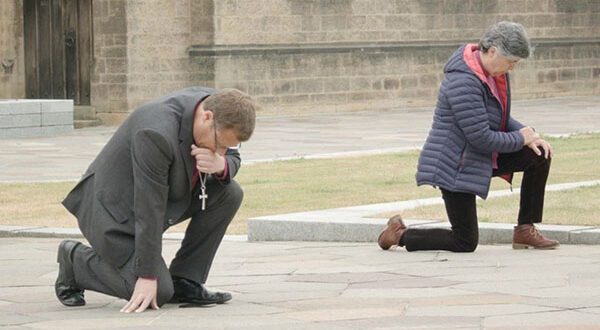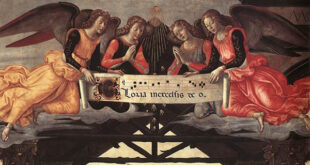Genuflection is one of the most ancient and profound gestures in Catholic liturgy and devotion. This act of bending the knee, simple in its execution yet deep in its meaning, is a tangible expression of reverence, worship, and submission before the presence of God. For many Catholics, genuflection may seem like a routine gesture, but its historical, theological, and spiritual significance offers a wealth of meanings that deserve to be explored and understood more deeply.
This article aims to unpack the spiritual and theological meaning of genuflection, its history in Christian tradition, and how this act of devotion can enrich our life of faith in the modern world.
The Origins and History of Genuflection
Genuflection as a gesture of reverence and submission has ancient roots. In the cultures of antiquity, especially in Roman and Greek civilizations, kneeling or bowing was a sign of respect before figures of authority, such as emperors, kings, or high dignitaries. In this sense, the gesture implied a recognition of the other’s power and superiority.
In the Christian tradition, this gesture was adopted from the earliest centuries as an expression of humility and worship, but applied solely to God. Genuflection before the Blessed Sacrament is a distinctive gesture that Catholics have maintained for centuries, in recognition of the real presence of Christ in the Eucharist.
Since the Council of Nicaea (325 A.D.), the Church affirmed the importance of worship toward the Lord, and over time, genuflection became a common practice in liturgy, particularly before the consecration of the bread and wine, when the priest genuflects before the sacramental presence of Christ on the altar.
Theological Meaning of Genuflection
At its core, genuflection is an act of worship. It is not simply a gesture of human courtesy or respect, but a bodily declaration of the centrality of God in our lives. Bending the knee before God is a physical act symbolizing the total surrender of our will and being to His divine majesty. The Catechism of the Catholic Church teaches that “to adore God is to acknowledge Him as God, as Creator and Savior, the Lord and Master of everything that exists” (CCC, 2096). Therefore, genuflection is a physical manifestation of this spiritual truth.
Genuflection and the Real Presence of Christ
One of the main reasons Catholics genuflect is to honor the real presence of Jesus Christ in the Eucharist. In the Catholic tradition, the bread and wine consecrated during Mass become, through transubstantiation, the Body and Blood of Christ. This transformation is not symbolic but real; thus, the presence of Jesus in the tabernacle or monstrance during Eucharistic adoration deserves a gesture of reverence. Genuflection expresses this faith in the living and true presence of Christ among His people.
The Power of the Gesture: More Than a Physical Action
Though genuflection is a physical act, its meaning transcends the visible. It is an action that involves the whole person. St. Paul, in his Letter to the Philippians, says, “At the name of Jesus, every knee should bend, in heaven and on earth and under the earth” (Philippians 2:10). This biblical passage expresses the idea that bending the knee before Jesus is not just an external action but a reflection of an inner reality: the recognition of Christ as Lord of all creation.
Therefore, genuflection is a form of prayer in itself. In a world where the fast pace of life often pushes us to act without thinking, genuflection invites us to stop, to become aware of God’s majesty, and to express, even with our body, our deep desire to worship Him.
Practical Applications: How Genuflection Can Enrich Our Faith
1. Genuflection in the Liturgy
In the liturgical context, genuflection holds a privileged place. Upon entering a church and approaching the altar, genuflecting before the tabernacle is a sign of recognizing Christ’s presence. This gesture, though brief, can be a moment of deep prayer and connection with God. Before genuflecting, we can pause briefly and offer an internal prayer of praise or supplication, remembering that we are in the presence of our Savior.
2. Genuflection in Daily Life
Beyond the liturgical context, genuflection can serve as a constant reminder of our relationship with God. While we may not necessarily kneel in the middle of the street or at work, the spirit of genuflection—humility, submission, and worship—can accompany us in all our actions. For example, before making important decisions or at the beginning and end of the day, we can pause to spiritually “bend the knee” before God, acknowledging His sovereignty and seeking His guidance.
3. Genuflection and Eucharistic Adoration
During Eucharistic adoration, genuflection takes on special significance. By kneeling or genuflecting before the monstrance, we participate in a profound act of respect and worship. This gesture invites us to enter into an attitude of contemplation and meditation, recognizing that we are in the living presence of God. Eucharistic adoration, accompanied by genuflections, helps us cultivate a humble and grateful heart, ready to receive God’s grace.
Genuflection and Modern Culture
In a world that often promotes self-sufficiency and individualism, genuflection reminds us that we are not the center of the universe. Bending the knee before God is a countercultural act in a society that values personal success and autonomy above all. This gesture teaches us the importance of humility, of recognizing our own limitations, and of our absolute dependence on divine grace.
Furthermore, in a time when many religious gestures have lost their meaning for some people, genuflection invites us to rediscover the power of symbols and gestures in our spiritual life. The Catholic Church’s liturgy is rich in symbolic gestures that express deep truths, and genuflection is one of them. By reviving and giving new meaning to these gestures, we can find a renewed source of spirituality and connection to the sacred.
Conclusion
Genuflection is much more than a simple physical act. It is a powerful gesture of faith that, when performed with awareness and devotion, allows us to enter into a deeper relationship with God. By bending the knee, we are reminded of our smallness before His greatness, our dependence on His mercy, and our desire to worship Him with our whole being.
May the next time we genuflect, whether entering a church, during Eucharistic adoration, or in the Mass, we do so with hearts full of love and reverence, aware that we are in the presence of Christ Himself, our Lord and Savior. In a world that often forgets the sacred, genuflection reminds us that there is a God who is worthy of all our worship, and that our most humble act, when offered in love, can be a powerful expression of our faith.






